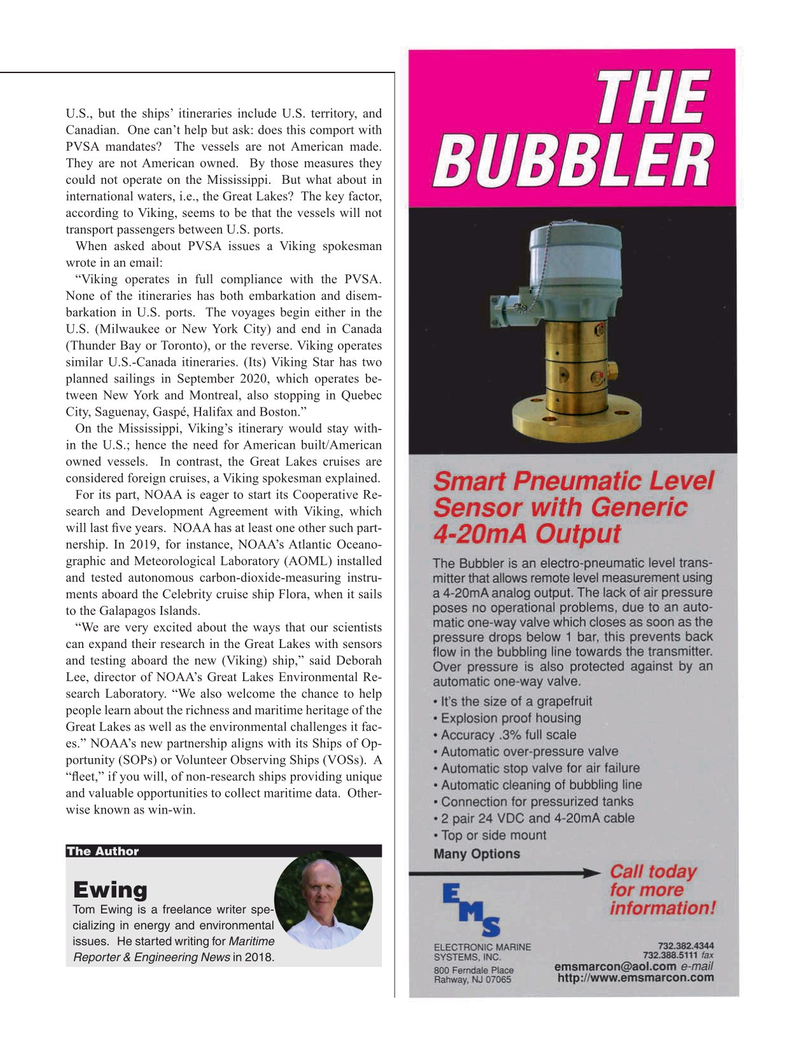
Page 15: of Maritime Reporter Magazine (March 2020)
Cruise Shipping Annual
Read this page in Pdf, Flash or Html5 edition of March 2020 Maritime Reporter Magazine
U.S., but the ships’ itineraries include U.S. territory, and
Canadian. One can’t help but ask: does this comport with
PVSA mandates? The vessels are not American made.
They are not American owned. By those measures they could not operate on the Mississippi. But what about in international waters, i.e., the Great Lakes? The key factor, according to Viking, seems to be that the vessels will not transport passengers between U.S. ports.
When asked about PVSA issues a Viking spokesman wrote in an email: “Viking operates in full compliance with the PVSA.
None of the itineraries has both embarkation and disem- barkation in U.S. ports. The voyages begin either in the
U.S. (Milwaukee or New York City) and end in Canada (Thunder Bay or Toronto), or the reverse. Viking operates similar U.S.-Canada itineraries. (Its) Viking Star has two planned sailings in September 2020, which operates be- tween New York and Montreal, also stopping in Quebec
City, Saguenay, Gaspé, Halifax and Boston.”
On the Mississippi, Viking’s itinerary would stay with- in the U.S.; hence the need for American built/American owned vessels. In contrast, the Great Lakes cruises are considered foreign cruises, a Viking spokesman explained.
For its part, NOAA is eager to start its Cooperative Re- search and Development Agreement with Viking, which will last ? ve years. NOAA has at least one other such part- nership. In 2019, for instance, NOAA’s Atlantic Oceano- graphic and Meteorological Laboratory (AOML) installed and tested autonomous carbon-dioxide-measuring instru- ments aboard the Celebrity cruise ship Flora, when it sails to the Galapagos Islands.
“We are very excited about the ways that our scientists can expand their research in the Great Lakes with sensors and testing aboard the new (Viking) ship,” said Deborah
Lee, director of NOAA’s Great Lakes Environmental Re- search Laboratory. “We also welcome the chance to help people learn about the richness and maritime heritage of the
Great Lakes as well as the environmental challenges it fac- es.” NOAA’s new partnership aligns with its Ships of Op- portunity (SOPs) or Volunteer Observing Ships (VOSs). A “? eet,” if you will, of non-research ships providing unique and valuable opportunities to collect maritime data. Other- wise known as win-win.
The Author
Ewing
Tom Ewing is a freelance writer spe- cializing in energy and environmental issues. He started writing for Maritime
Reporter & Engineering News in 2018.
MR #3 (1-17).indd 15 3/4/2020 10:50:48 AM

 14
14

 16
16
